Financial Reporting Analysis: Accounting Standard and Regulation
VerifiedAdded on 2021/05/31
|7
|1925
|72
Report
AI Summary
This report analyzes the financial statements of Vicinity Centres, a company engaged in the retail business, focusing on its accounting policies and the preparation of its financial statements according to the general purpose financial reporting framework. The report identifies the management policies for recognizing and measuring investments, particularly investment properties measured initially at cost and then at fair value. It also examines the impact of potential changes in the retail business, such as increased competition and changes in lease accounting, on the company's financial reports, including sales generation capacity and key metrics like gearing rate and EBITDA. The economic consequences of these changes, affecting revenue, costs, and customer preferences, are also discussed, providing a comprehensive overview of the financial and operational challenges faced by Vicinity Centres within the evolving Australian retail market. The report references various accounting standards and research papers to support its analysis.
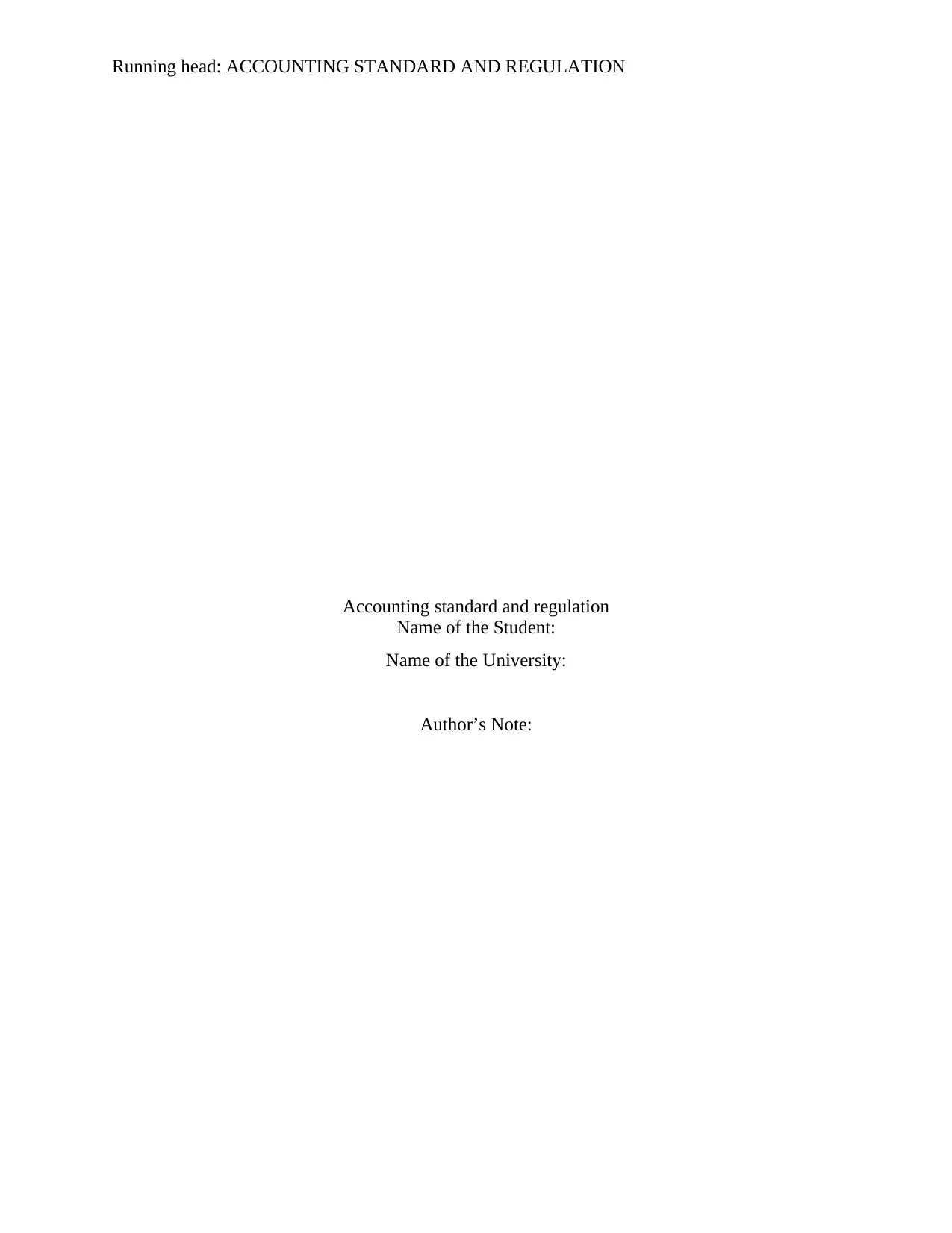
Running head: ACCOUNTING STANDARD AND REGULATION
Accounting standard and regulation
Name of the Student:
Name of the University:
Author’s Note:
Accounting standard and regulation
Name of the Student:
Name of the University:
Author’s Note:
Paraphrase This Document
Need a fresh take? Get an instant paraphrase of this document with our AI Paraphraser
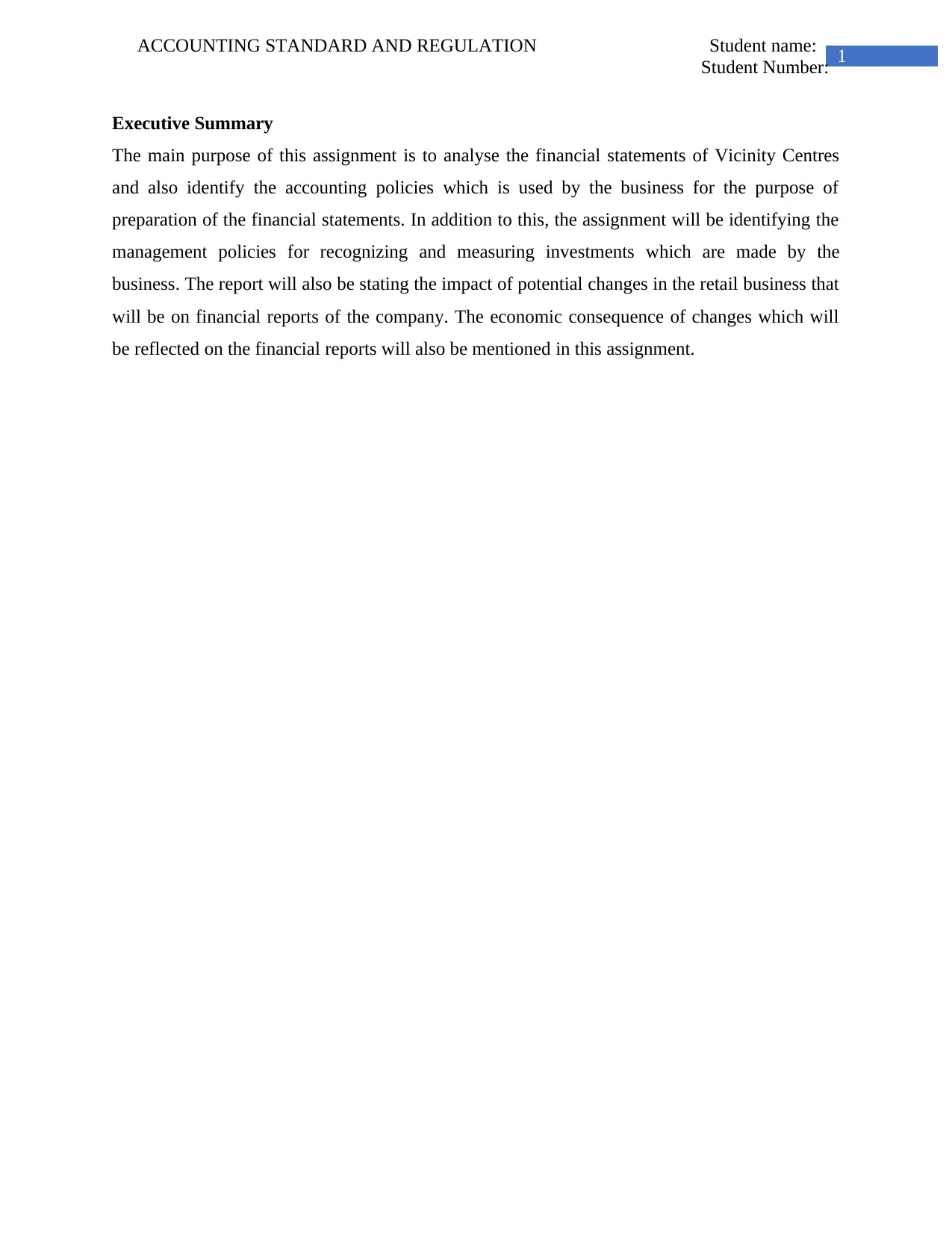
1
ACCOUNTING STANDARD AND REGULATION Student name:
Student Number:
Executive Summary
The main purpose of this assignment is to analyse the financial statements of Vicinity Centres
and also identify the accounting policies which is used by the business for the purpose of
preparation of the financial statements. In addition to this, the assignment will be identifying the
management policies for recognizing and measuring investments which are made by the
business. The report will also be stating the impact of potential changes in the retail business that
will be on financial reports of the company. The economic consequence of changes which will
be reflected on the financial reports will also be mentioned in this assignment.
ACCOUNTING STANDARD AND REGULATION Student name:
Student Number:
Executive Summary
The main purpose of this assignment is to analyse the financial statements of Vicinity Centres
and also identify the accounting policies which is used by the business for the purpose of
preparation of the financial statements. In addition to this, the assignment will be identifying the
management policies for recognizing and measuring investments which are made by the
business. The report will also be stating the impact of potential changes in the retail business that
will be on financial reports of the company. The economic consequence of changes which will
be reflected on the financial reports will also be mentioned in this assignment.
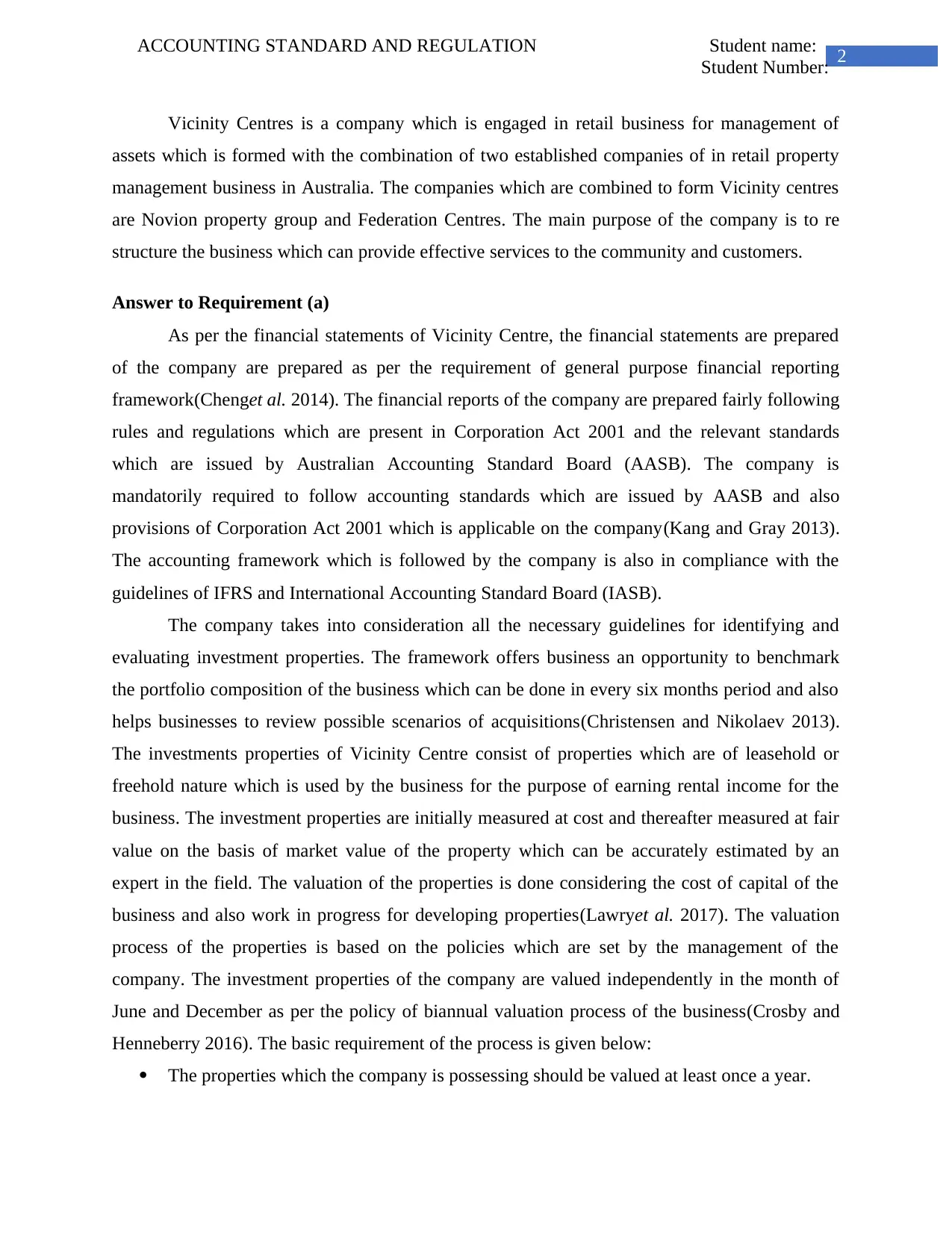
2
ACCOUNTING STANDARD AND REGULATION Student name:
Student Number:
Vicinity Centres is a company which is engaged in retail business for management of
assets which is formed with the combination of two established companies of in retail property
management business in Australia. The companies which are combined to form Vicinity centres
are Novion property group and Federation Centres. The main purpose of the company is to re
structure the business which can provide effective services to the community and customers.
Answer to Requirement (a)
As per the financial statements of Vicinity Centre, the financial statements are prepared
of the company are prepared as per the requirement of general purpose financial reporting
framework(Chenget al. 2014). The financial reports of the company are prepared fairly following
rules and regulations which are present in Corporation Act 2001 and the relevant standards
which are issued by Australian Accounting Standard Board (AASB). The company is
mandatorily required to follow accounting standards which are issued by AASB and also
provisions of Corporation Act 2001 which is applicable on the company(Kang and Gray 2013).
The accounting framework which is followed by the company is also in compliance with the
guidelines of IFRS and International Accounting Standard Board (IASB).
The company takes into consideration all the necessary guidelines for identifying and
evaluating investment properties. The framework offers business an opportunity to benchmark
the portfolio composition of the business which can be done in every six months period and also
helps businesses to review possible scenarios of acquisitions(Christensen and Nikolaev 2013).
The investments properties of Vicinity Centre consist of properties which are of leasehold or
freehold nature which is used by the business for the purpose of earning rental income for the
business. The investment properties are initially measured at cost and thereafter measured at fair
value on the basis of market value of the property which can be accurately estimated by an
expert in the field. The valuation of the properties is done considering the cost of capital of the
business and also work in progress for developing properties(Lawryet al. 2017). The valuation
process of the properties is based on the policies which are set by the management of the
company. The investment properties of the company are valued independently in the month of
June and December as per the policy of biannual valuation process of the business(Crosby and
Henneberry 2016). The basic requirement of the process is given below:
The properties which the company is possessing should be valued at least once a year.
ACCOUNTING STANDARD AND REGULATION Student name:
Student Number:
Vicinity Centres is a company which is engaged in retail business for management of
assets which is formed with the combination of two established companies of in retail property
management business in Australia. The companies which are combined to form Vicinity centres
are Novion property group and Federation Centres. The main purpose of the company is to re
structure the business which can provide effective services to the community and customers.
Answer to Requirement (a)
As per the financial statements of Vicinity Centre, the financial statements are prepared
of the company are prepared as per the requirement of general purpose financial reporting
framework(Chenget al. 2014). The financial reports of the company are prepared fairly following
rules and regulations which are present in Corporation Act 2001 and the relevant standards
which are issued by Australian Accounting Standard Board (AASB). The company is
mandatorily required to follow accounting standards which are issued by AASB and also
provisions of Corporation Act 2001 which is applicable on the company(Kang and Gray 2013).
The accounting framework which is followed by the company is also in compliance with the
guidelines of IFRS and International Accounting Standard Board (IASB).
The company takes into consideration all the necessary guidelines for identifying and
evaluating investment properties. The framework offers business an opportunity to benchmark
the portfolio composition of the business which can be done in every six months period and also
helps businesses to review possible scenarios of acquisitions(Christensen and Nikolaev 2013).
The investments properties of Vicinity Centre consist of properties which are of leasehold or
freehold nature which is used by the business for the purpose of earning rental income for the
business. The investment properties are initially measured at cost and thereafter measured at fair
value on the basis of market value of the property which can be accurately estimated by an
expert in the field. The valuation of the properties is done considering the cost of capital of the
business and also work in progress for developing properties(Lawryet al. 2017). The valuation
process of the properties is based on the policies which are set by the management of the
company. The investment properties of the company are valued independently in the month of
June and December as per the policy of biannual valuation process of the business(Crosby and
Henneberry 2016). The basic requirement of the process is given below:
The properties which the company is possessing should be valued at least once a year.
⊘ This is a preview!⊘
Do you want full access?
Subscribe today to unlock all pages.

Trusted by 1+ million students worldwide
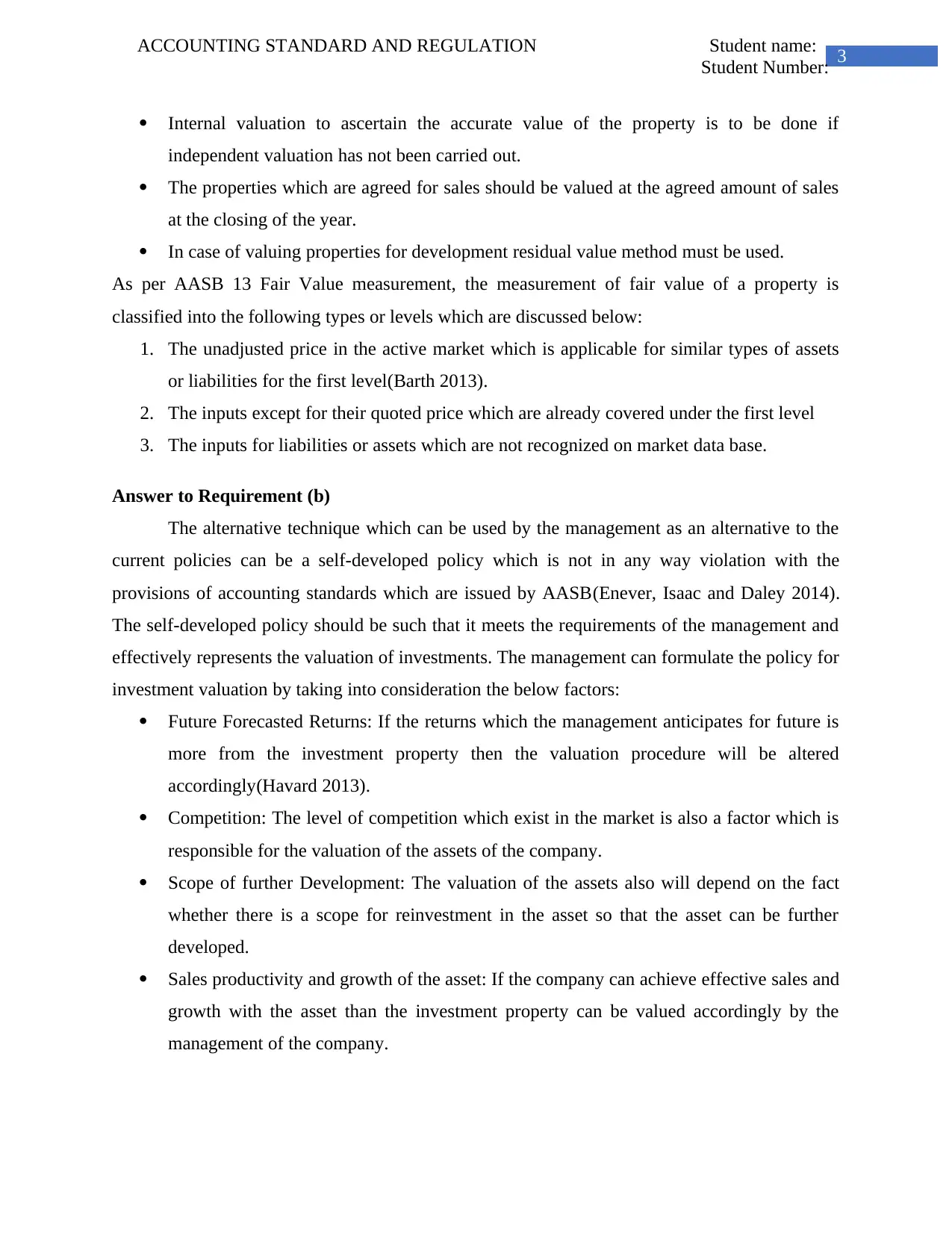
3
ACCOUNTING STANDARD AND REGULATION Student name:
Student Number:
Internal valuation to ascertain the accurate value of the property is to be done if
independent valuation has not been carried out.
The properties which are agreed for sales should be valued at the agreed amount of sales
at the closing of the year.
In case of valuing properties for development residual value method must be used.
As per AASB 13 Fair Value measurement, the measurement of fair value of a property is
classified into the following types or levels which are discussed below:
1. The unadjusted price in the active market which is applicable for similar types of assets
or liabilities for the first level(Barth 2013).
2. The inputs except for their quoted price which are already covered under the first level
3. The inputs for liabilities or assets which are not recognized on market data base.
Answer to Requirement (b)
The alternative technique which can be used by the management as an alternative to the
current policies can be a self-developed policy which is not in any way violation with the
provisions of accounting standards which are issued by AASB(Enever, Isaac and Daley 2014).
The self-developed policy should be such that it meets the requirements of the management and
effectively represents the valuation of investments. The management can formulate the policy for
investment valuation by taking into consideration the below factors:
Future Forecasted Returns: If the returns which the management anticipates for future is
more from the investment property then the valuation procedure will be altered
accordingly(Havard 2013).
Competition: The level of competition which exist in the market is also a factor which is
responsible for the valuation of the assets of the company.
Scope of further Development: The valuation of the assets also will depend on the fact
whether there is a scope for reinvestment in the asset so that the asset can be further
developed.
Sales productivity and growth of the asset: If the company can achieve effective sales and
growth with the asset than the investment property can be valued accordingly by the
management of the company.
ACCOUNTING STANDARD AND REGULATION Student name:
Student Number:
Internal valuation to ascertain the accurate value of the property is to be done if
independent valuation has not been carried out.
The properties which are agreed for sales should be valued at the agreed amount of sales
at the closing of the year.
In case of valuing properties for development residual value method must be used.
As per AASB 13 Fair Value measurement, the measurement of fair value of a property is
classified into the following types or levels which are discussed below:
1. The unadjusted price in the active market which is applicable for similar types of assets
or liabilities for the first level(Barth 2013).
2. The inputs except for their quoted price which are already covered under the first level
3. The inputs for liabilities or assets which are not recognized on market data base.
Answer to Requirement (b)
The alternative technique which can be used by the management as an alternative to the
current policies can be a self-developed policy which is not in any way violation with the
provisions of accounting standards which are issued by AASB(Enever, Isaac and Daley 2014).
The self-developed policy should be such that it meets the requirements of the management and
effectively represents the valuation of investments. The management can formulate the policy for
investment valuation by taking into consideration the below factors:
Future Forecasted Returns: If the returns which the management anticipates for future is
more from the investment property then the valuation procedure will be altered
accordingly(Havard 2013).
Competition: The level of competition which exist in the market is also a factor which is
responsible for the valuation of the assets of the company.
Scope of further Development: The valuation of the assets also will depend on the fact
whether there is a scope for reinvestment in the asset so that the asset can be further
developed.
Sales productivity and growth of the asset: If the company can achieve effective sales and
growth with the asset than the investment property can be valued accordingly by the
management of the company.
Paraphrase This Document
Need a fresh take? Get an instant paraphrase of this document with our AI Paraphraser
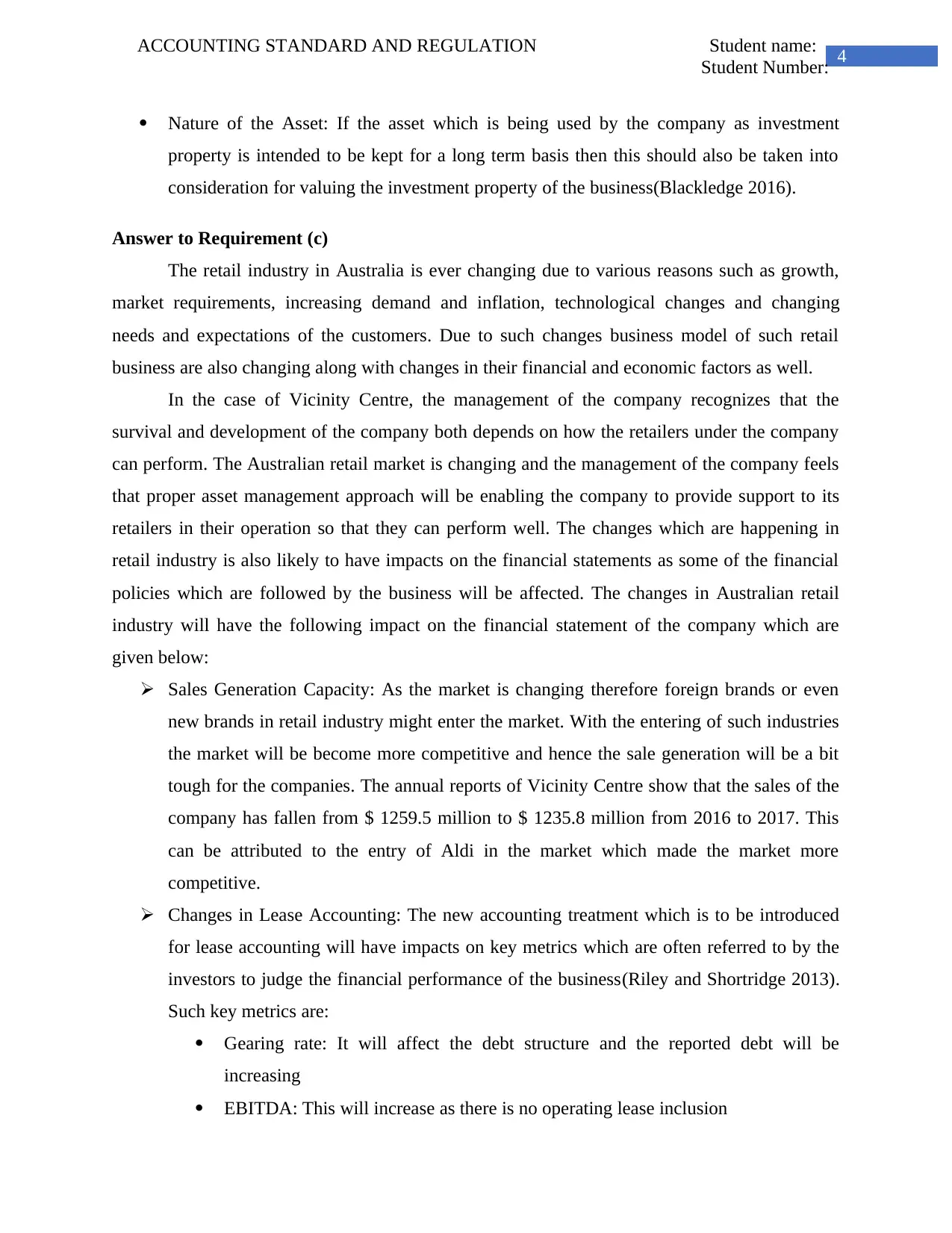
4
ACCOUNTING STANDARD AND REGULATION Student name:
Student Number:
Nature of the Asset: If the asset which is being used by the company as investment
property is intended to be kept for a long term basis then this should also be taken into
consideration for valuing the investment property of the business(Blackledge 2016).
Answer to Requirement (c)
The retail industry in Australia is ever changing due to various reasons such as growth,
market requirements, increasing demand and inflation, technological changes and changing
needs and expectations of the customers. Due to such changes business model of such retail
business are also changing along with changes in their financial and economic factors as well.
In the case of Vicinity Centre, the management of the company recognizes that the
survival and development of the company both depends on how the retailers under the company
can perform. The Australian retail market is changing and the management of the company feels
that proper asset management approach will be enabling the company to provide support to its
retailers in their operation so that they can perform well. The changes which are happening in
retail industry is also likely to have impacts on the financial statements as some of the financial
policies which are followed by the business will be affected. The changes in Australian retail
industry will have the following impact on the financial statement of the company which are
given below:
Sales Generation Capacity: As the market is changing therefore foreign brands or even
new brands in retail industry might enter the market. With the entering of such industries
the market will be become more competitive and hence the sale generation will be a bit
tough for the companies. The annual reports of Vicinity Centre show that the sales of the
company has fallen from $ 1259.5 million to $ 1235.8 million from 2016 to 2017. This
can be attributed to the entry of Aldi in the market which made the market more
competitive.
Changes in Lease Accounting: The new accounting treatment which is to be introduced
for lease accounting will have impacts on key metrics which are often referred to by the
investors to judge the financial performance of the business(Riley and Shortridge 2013).
Such key metrics are:
Gearing rate: It will affect the debt structure and the reported debt will be
increasing
EBITDA: This will increase as there is no operating lease inclusion
ACCOUNTING STANDARD AND REGULATION Student name:
Student Number:
Nature of the Asset: If the asset which is being used by the company as investment
property is intended to be kept for a long term basis then this should also be taken into
consideration for valuing the investment property of the business(Blackledge 2016).
Answer to Requirement (c)
The retail industry in Australia is ever changing due to various reasons such as growth,
market requirements, increasing demand and inflation, technological changes and changing
needs and expectations of the customers. Due to such changes business model of such retail
business are also changing along with changes in their financial and economic factors as well.
In the case of Vicinity Centre, the management of the company recognizes that the
survival and development of the company both depends on how the retailers under the company
can perform. The Australian retail market is changing and the management of the company feels
that proper asset management approach will be enabling the company to provide support to its
retailers in their operation so that they can perform well. The changes which are happening in
retail industry is also likely to have impacts on the financial statements as some of the financial
policies which are followed by the business will be affected. The changes in Australian retail
industry will have the following impact on the financial statement of the company which are
given below:
Sales Generation Capacity: As the market is changing therefore foreign brands or even
new brands in retail industry might enter the market. With the entering of such industries
the market will be become more competitive and hence the sale generation will be a bit
tough for the companies. The annual reports of Vicinity Centre show that the sales of the
company has fallen from $ 1259.5 million to $ 1235.8 million from 2016 to 2017. This
can be attributed to the entry of Aldi in the market which made the market more
competitive.
Changes in Lease Accounting: The new accounting treatment which is to be introduced
for lease accounting will have impacts on key metrics which are often referred to by the
investors to judge the financial performance of the business(Riley and Shortridge 2013).
Such key metrics are:
Gearing rate: It will affect the debt structure and the reported debt will be
increasing
EBITDA: This will increase as there is no operating lease inclusion
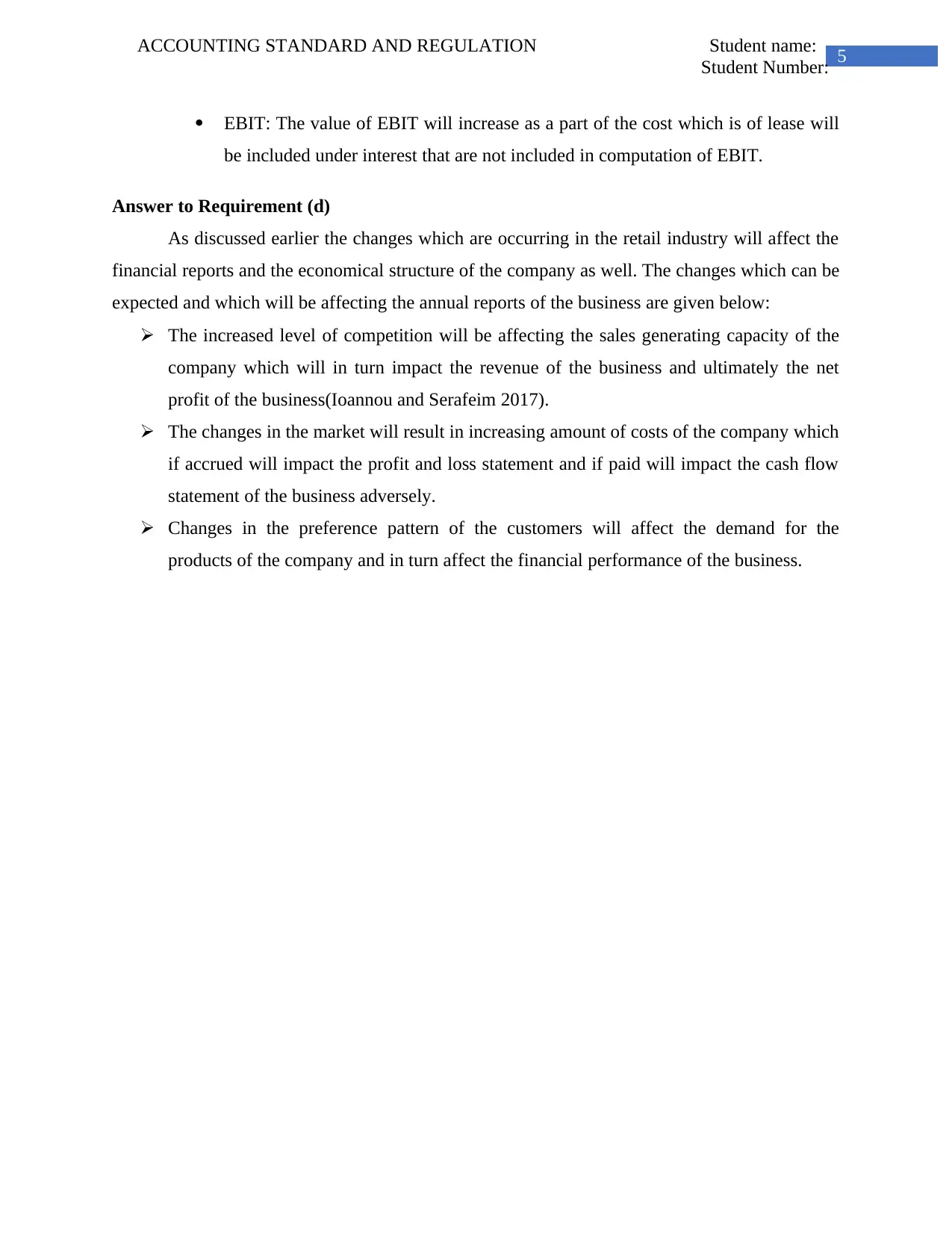
5
ACCOUNTING STANDARD AND REGULATION Student name:
Student Number:
EBIT: The value of EBIT will increase as a part of the cost which is of lease will
be included under interest that are not included in computation of EBIT.
Answer to Requirement (d)
As discussed earlier the changes which are occurring in the retail industry will affect the
financial reports and the economical structure of the company as well. The changes which can be
expected and which will be affecting the annual reports of the business are given below:
The increased level of competition will be affecting the sales generating capacity of the
company which will in turn impact the revenue of the business and ultimately the net
profit of the business(Ioannou and Serafeim 2017).
The changes in the market will result in increasing amount of costs of the company which
if accrued will impact the profit and loss statement and if paid will impact the cash flow
statement of the business adversely.
Changes in the preference pattern of the customers will affect the demand for the
products of the company and in turn affect the financial performance of the business.
ACCOUNTING STANDARD AND REGULATION Student name:
Student Number:
EBIT: The value of EBIT will increase as a part of the cost which is of lease will
be included under interest that are not included in computation of EBIT.
Answer to Requirement (d)
As discussed earlier the changes which are occurring in the retail industry will affect the
financial reports and the economical structure of the company as well. The changes which can be
expected and which will be affecting the annual reports of the business are given below:
The increased level of competition will be affecting the sales generating capacity of the
company which will in turn impact the revenue of the business and ultimately the net
profit of the business(Ioannou and Serafeim 2017).
The changes in the market will result in increasing amount of costs of the company which
if accrued will impact the profit and loss statement and if paid will impact the cash flow
statement of the business adversely.
Changes in the preference pattern of the customers will affect the demand for the
products of the company and in turn affect the financial performance of the business.
⊘ This is a preview!⊘
Do you want full access?
Subscribe today to unlock all pages.

Trusted by 1+ million students worldwide
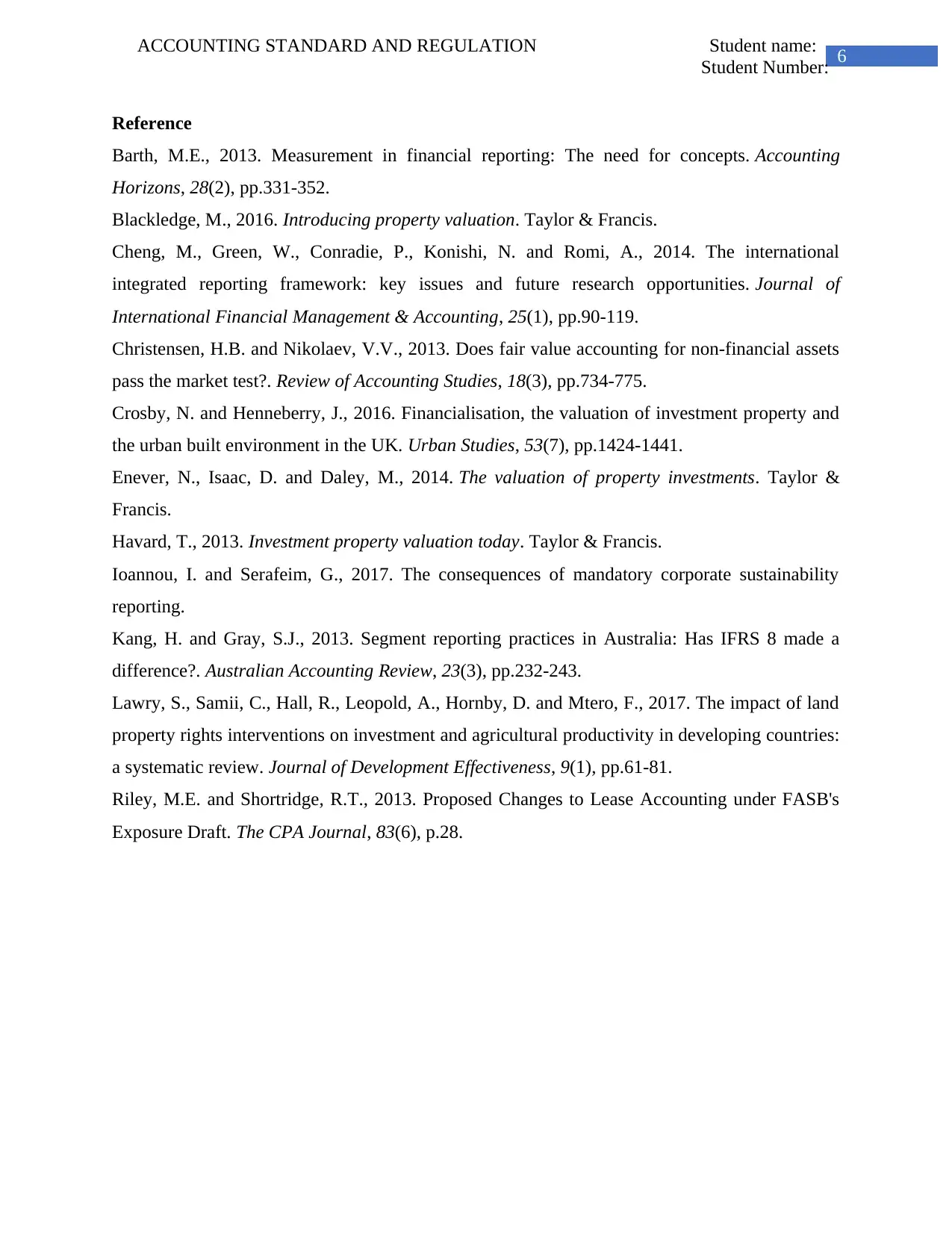
6
ACCOUNTING STANDARD AND REGULATION Student name:
Student Number:
Reference
Barth, M.E., 2013. Measurement in financial reporting: The need for concepts. Accounting
Horizons, 28(2), pp.331-352.
Blackledge, M., 2016. Introducing property valuation. Taylor & Francis.
Cheng, M., Green, W., Conradie, P., Konishi, N. and Romi, A., 2014. The international
integrated reporting framework: key issues and future research opportunities. Journal of
International Financial Management & Accounting, 25(1), pp.90-119.
Christensen, H.B. and Nikolaev, V.V., 2013. Does fair value accounting for non-financial assets
pass the market test?. Review of Accounting Studies, 18(3), pp.734-775.
Crosby, N. and Henneberry, J., 2016. Financialisation, the valuation of investment property and
the urban built environment in the UK. Urban Studies, 53(7), pp.1424-1441.
Enever, N., Isaac, D. and Daley, M., 2014. The valuation of property investments. Taylor &
Francis.
Havard, T., 2013. Investment property valuation today. Taylor & Francis.
Ioannou, I. and Serafeim, G., 2017. The consequences of mandatory corporate sustainability
reporting.
Kang, H. and Gray, S.J., 2013. Segment reporting practices in Australia: Has IFRS 8 made a
difference?. Australian Accounting Review, 23(3), pp.232-243.
Lawry, S., Samii, C., Hall, R., Leopold, A., Hornby, D. and Mtero, F., 2017. The impact of land
property rights interventions on investment and agricultural productivity in developing countries:
a systematic review. Journal of Development Effectiveness, 9(1), pp.61-81.
Riley, M.E. and Shortridge, R.T., 2013. Proposed Changes to Lease Accounting under FASB's
Exposure Draft. The CPA Journal, 83(6), p.28.
ACCOUNTING STANDARD AND REGULATION Student name:
Student Number:
Reference
Barth, M.E., 2013. Measurement in financial reporting: The need for concepts. Accounting
Horizons, 28(2), pp.331-352.
Blackledge, M., 2016. Introducing property valuation. Taylor & Francis.
Cheng, M., Green, W., Conradie, P., Konishi, N. and Romi, A., 2014. The international
integrated reporting framework: key issues and future research opportunities. Journal of
International Financial Management & Accounting, 25(1), pp.90-119.
Christensen, H.B. and Nikolaev, V.V., 2013. Does fair value accounting for non-financial assets
pass the market test?. Review of Accounting Studies, 18(3), pp.734-775.
Crosby, N. and Henneberry, J., 2016. Financialisation, the valuation of investment property and
the urban built environment in the UK. Urban Studies, 53(7), pp.1424-1441.
Enever, N., Isaac, D. and Daley, M., 2014. The valuation of property investments. Taylor &
Francis.
Havard, T., 2013. Investment property valuation today. Taylor & Francis.
Ioannou, I. and Serafeim, G., 2017. The consequences of mandatory corporate sustainability
reporting.
Kang, H. and Gray, S.J., 2013. Segment reporting practices in Australia: Has IFRS 8 made a
difference?. Australian Accounting Review, 23(3), pp.232-243.
Lawry, S., Samii, C., Hall, R., Leopold, A., Hornby, D. and Mtero, F., 2017. The impact of land
property rights interventions on investment and agricultural productivity in developing countries:
a systematic review. Journal of Development Effectiveness, 9(1), pp.61-81.
Riley, M.E. and Shortridge, R.T., 2013. Proposed Changes to Lease Accounting under FASB's
Exposure Draft. The CPA Journal, 83(6), p.28.
1 out of 7
Related Documents
Your All-in-One AI-Powered Toolkit for Academic Success.
+13062052269
info@desklib.com
Available 24*7 on WhatsApp / Email
![[object Object]](/_next/static/media/star-bottom.7253800d.svg)
Unlock your academic potential
Copyright © 2020–2025 A2Z Services. All Rights Reserved. Developed and managed by ZUCOL.





